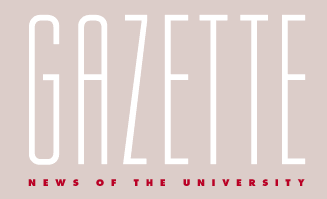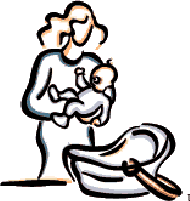 |
|
 NEW
NAME FOR LAW SCHOOL
NEW
NAME FOR LAW SCHOOL
It’s not “the law school” anymore. In November, the College
of Law was renamed the S.J. Quinney College of Law. The S.J. and Jessie
E. Quinney Foundation has provided $30 million in support to the college,
which includes a $26 million endowment gift to be paid out over 10 years.
It is one of the largest gifts in University history and will support
student scholarships, the law library, professorships, and special academic
programs, as well as assist with faculty and student recruitment and curriculum
enhancement.
“We
are grateful beyond words,” said the usually loquacious Scott M.
Matheson Jr., dean of the college. “This magnificent gift will propel
our law school to the highest levels of quality and achievement in legal
education.” Quinney, a Logan native, founded the law firm Ray, Quinney
& Nebeker with two partners. He was a leader in the growth of Utah’s
ski industry and had a life-long respect for the environment. The Quinney
Foundation helped to establish the Wallace Stegner Center for Land, Resources
and the Environment at the College of Law in 1996.
Back to Top.
AND SPEAKING OF THE LAW SCHOOL…
At about the time the University of Deseret (now, of course, the U of U) was founded, John Wesley Powell became the first European American to navigate the Colorado River through the American Southwest. That journey marked the beginning of Western settlement patterns that continue today. Fifty years ago, Powell’s life was chronicled by Wallace Stegner BA’30 in Beyond the Hundredth Meridian: John Wesley Powell and the Second Opening of the West.
To observe the 50th anniversary of the book, which earned Stegner international acclaim, the aforementioned Wallace Stegner Center for Land, Resources and the Environment at the S.J. Quinney College of Law has made Powell and Stegner the focus of its seventh annual symposium April 12 at the Sutherland Moot Courtroom. The center has gathered a group of distinguished writers to offer perspectives on Powell, Stegner, and the American West, including Charles Wilkinson of the University of Colorado School of Law; Donald Worster of the University of Kansas; Jackson Benson, author of the leading biographies of Wallace Stegner and John Steinbeck; and several others. “Coming just after the Olympics, we hope to offer a perspective on the West that balances some of the ‘Western’ images likely to be promoted by the international media during the Games,” says Keith Bartholomew, associate director of the center. The symposium generally focuses on public issues that affect the region and the environment. Past topics have included metropolitan growth, the presidency and the environment, and ecological restoration.
For more information on the symposium, contact Keith Bartholomew at 801-585-9695, or visit www.law.utah.edu/Stegner/.
CAPECCHI
WINS LASKER
![]() Mario
Capecchi, Distinguished Professor of Human Genetics and Biology, was named
a co-recipient of the 2001 Albert Lasker Award for Basic Medical Research
in September. Often called “America’s Nobel Prize,” the
award is the nation’s most distinguished honor for outstanding contributions
to basic medical research. It was presented to Capecchi, Martin Evans
of Cardiff University (Wales), and Oliver Smithies of the University of
North Carolina for their development of a technology for manipulating
the mouse genome that allows the creation of animal models of human disease.
The technology enables scientists to disable—or knock out—a
gene as well as change its properties in subtle ways. The procedures generate
animals that carry specific genetic alterations and recreate the underlying
cause of a human disorder or uncover the role of particular genes. Capecchi,
born in Italy, came to the University in 1973 after studying at Harvard
under James D. Watson, who shared a Nobel Prize with Francis Crick for
discovering the structure of DNA. Capecchi was a 1998 recipient of the
University’s Rosenblatt Prize (Continuum, Winter 1998).
Mario
Capecchi, Distinguished Professor of Human Genetics and Biology, was named
a co-recipient of the 2001 Albert Lasker Award for Basic Medical Research
in September. Often called “America’s Nobel Prize,” the
award is the nation’s most distinguished honor for outstanding contributions
to basic medical research. It was presented to Capecchi, Martin Evans
of Cardiff University (Wales), and Oliver Smithies of the University of
North Carolina for their development of a technology for manipulating
the mouse genome that allows the creation of animal models of human disease.
The technology enables scientists to disable—or knock out—a
gene as well as change its properties in subtle ways. The procedures generate
animals that carry specific genetic alterations and recreate the underlying
cause of a human disorder or uncover the role of particular genes. Capecchi,
born in Italy, came to the University in 1973 after studying at Harvard
under James D. Watson, who shared a Nobel Prize with Francis Crick for
discovering the structure of DNA. Capecchi was a 1998 recipient of the
University’s Rosenblatt Prize (Continuum, Winter 1998).
SUSPENDING
PEDESTRIANS
With the completion of the George S. Eccles 2002 Legacy Bridge in December,
pedestrians crossing Wasatch
Drive as it cuts through the University campus will no longer face the
heart-pounding challenge of stepping in
front of speeding cars to gain access to upper and lower parts of campus.
The 300-foot-long
single-pylon bridge with cable-stayed suspension spans Wasatch near Medical
Drive and is one of only a few of its kind in the western United States.
It is designed for foot and bicycle traffic and provides
a link between the main campus and both the Health Sciences Center and
the Heritage Commons residential
living area. It will be permanently accessible after the Olympic security
period (Jan. 9 – Mar. 27).
The bridge incorporates a staircase and an elevator on the west plaza to accommodate a 30-foot drop in elevation. In addition, a sculpture of a skier, “Go for the Gold,” sits at the base of the staircase in front of a large red rock. The sculpture, by Jonathan Bronson, was donated by Robert L. Rice and Kenneth O. Melby.
COMMUNITY OUTREACH
As any alumna/us of the University knows, one never really “leaves” the U. Thus it comes as no surprise to find that Irene Fisher, retired as director of the Lowell Bennion Community Service Center (Continuum, Summer 2001), has returned to service as a special assistant to President Bernie Machen for campus community partnerships. In the new position, Fisher will make recommendations about how the University can provide additional resources and extend its influence to groups that have traditionally not been served. “Researching needs and cultures will aid us in understanding how the U can appeal to and better serve the diverse populations of Salt Lake City and its surrounding areas,” said Machen.
Fisher has been meeting extensively with nonprofits, organizations, and individuals in the Salt Lake valley to better understand community needs. “We want to underscore the importance of our interconnectedness by establishing formal and informal civic, social, academic, and entrepreneurial partnerships,” says Fisher. “I would like to reach a time when people don’t say ‘the University AND the community’—rather they’d think of the University WITHIN the community.”
Many U of U outreach programs have already made those connections. As examples, the Department of Pediatrics at the School of Medicine supports a pediatrician for the Wasatch Homeless Health Care Clinic; the Utah Museum of Natural History administers a program to teach science in elementary schools, utilizing junior high and high school students who are past participants in the program as teachers; and the Department of English runs a Family Literacy Center at West High School. The Alumni Association has initiated a service internship that will allow students to assist in projects such as these. “The good news is that there is more going on at the U than anyone realized,” says Fisher. “We hope to look for ways to work together to make what we’re doing more than just a sum of the parts.” To contact Fisher about existing community groups and/or unmet needs in the community, call 801-581-4519.
Back to Top.
 CANCEL
THE BABYSITTER
CANCEL
THE BABYSITTER
If
the term “college student” brings to mind an 18 year old wiling
away aimless hours in a dorm room, then it may be surprising to learn
that the average age of a U of U student is 25 (31 for graduate students),
that most have part- or full-time jobs, and that many have children of
their own. So the opening of the ASUU (Associated Students of the University
of Utah) Child Care Center in October was welcomed by many students who
are juggling family, work, and school responsibilities. The 1,300-square-foot
facility is located in the former home economics lab on the lower level
of the Alfred Emery Building. Priority placement for student families
accommodates up to 70 children (12 months through four years of age) per
day on a part-time basis. Since 1989, a small portion of student fees
has gone toward child-care needs for students, but a few years ago, ASUU
recognized the need for additional on-campus, part-time day care with
more slots for infants and toddlers.
The new center has received funding through accumulated ASUU child-care funds, and grants from the Herbert I. and Elsa B. Michael Foundation and the U.S. Department of Education. Kris Hale, the U’s child-care coordinator, oversees eight on-campus early childhood facilities serving about 600 children. Campus programs reach a broad range of families, with placement priorities from the specific (BioKids, for faculty, staff, and students of the biology department) to the more general (the Child and Family Development Center, a part-time, preschool program for all children). “The [ASUU] center will serve a critical need for University families,” Hale says. “We see offering quality child care as a recruitment and retention strategy that will have long-lasting effects for students and their children.” For more information on campus child care, visit www.childcare.utah.edu.
|
Marcus Jacobson,
71, chair of the Department of Neurobiology and Anatomy. Jacobson
came to the University in 1977 as one of the best-known researchers
of nervous system development, and his book, Developmental Neurobiology,
is in its third edition. Jacobson’s collection of modern Chinese
paintings and his collection of rare books on embryology and neuroscience
have been donated to the U. |

